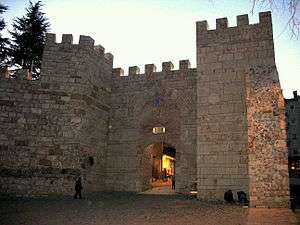Siege of Bursa
| Siege of Bursa | |||||||
|---|---|---|---|---|---|---|---|
| Part of the Byzantine-Ottoman wars | |||||||
 Gate of Bursa castle | |||||||
| |||||||
| Belligerents | |||||||
|
|
| ||||||
| Commanders and leaders | |||||||
|
|
| ||||||
| Strength | |||||||
| 12,000 | 10,000 | ||||||
The Siege of Bursa (also called Prusa, Prousa, Brusa or Broussa) occurred from 1317/20 until the capture on 6 April 1326,[1] when the Ottomans deployed a bold plan to seize Prusa (modern-day Bursa, Turkey). The Ottomans had not captured a city before; the lack of expertise and adequate siege equipment at this stage of the war meant that the city fell only after six or nine years.[2] According to some sources Osman I died of natural causes just before the fall of the city,[2] while others suggest that he lived long enough to hear about the victory on his death-bed[1][3][4] and was buried in Bursa afterwards.
Aftermath
After the fall of the city, his son and successor Orhan made Bursa the first official Ottoman capital and it remained so until 1366, when Edirne became the new capital.[2] As a result, Bursa holds a special place in Ottoman history as their founding city, and also as the birthplace of Ottoman architecture (Bursa Grand Mosque (1399), Bayezid I Mosque (1395), Hüdavendigar Mosque (1385), and Yeşil Mosque) (1421).[5] During his reign Orhan encouraged urban growth through the construction of buildings such as imarets, Turkish baths, mosques, inns and caravanserais,[6] and he also build a mosque and a medrese in what is now known as the Hisar district,[7] and after his death was buried there in his türbe (mausoleum) next to his father.[5] The Muslim traveler Ibn Battuta who visited Bursa in 1331 was impressed by the sultan and found Bursa an enjoyable city[5] "with fine bazaars and wide streets, surrounded on all sides by gardens and running springs."[8]
Importance
Paul K. Davis writes, "The capture of Brusa established Osman I (Othman) and his successors as the major power in Asia Minor, beginning the Ottoman Empire."[9]
References
- 1 2 3 Rogers, Clifford (2010). The Oxford Encyclopaedia of Medieval Warfare and Military Technology. 1. Oxford University Press. p. 261. ISBN 9780195334036.
- 1 2 3 Nolan, Cathal J. (2006). The Age of Wars of Religion, 1000-1650: An Encyclopedia of Global Warfare and Civilization. 1. Greenwood Publishing Group. pp. 100–101. ISBN 9780313337338.
- ↑ Hore, A. H. (2003). Eighteen Centuries of the Orthodox Greek Church. Gorgias Press LLC. p. 455. ISBN 9781593330514.
- ↑ Pitcher, Donald Edgar (1972). An Historical Geography of the Ottoman Empire: From Earliest Times to the End of the Sixteenth Century. Brill Archive. p. 37.
- 1 2 3 Dumper, Michael R. T.; Stanley, Bruce E. (2007). Cities of the Middle East and North Africa: A Historical Encyclopedia. ABC-CLIO. p. 101. ISBN 9781576079195.
- ↑ Ágoston, Gábor; Masters, Bruce Alan (2009). Encyclopedia of the Ottoman Empire. Infobase Publishing. p. 105. ISBN 9781438110257.
- ↑ Levine, Lynn A. (2010). Frommer's Istanbul (2 ed.). John Wiley & Sons. p. 238. ISBN 9780470915790.
- ↑ Finkel, Caroline (2007). Osman's Dream: The History of the Ottoman Empire. Basic Books. p. 13. ISBN 9780465008506.
- ↑ Paul K. Davis, 100 Decisive Battles from Ancient Times to the Present: The World’s Major Battles and How They Shaped History (Oxford: Oxford University Press, 1999), 151.
Coordinates: 40°11′00″N 29°04′00″E / 40.1833°N 29.0667°E